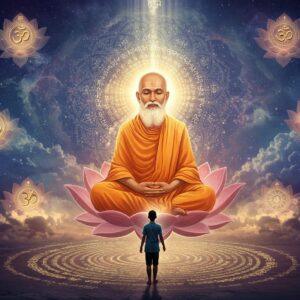
The world of Lord Shiva is deeply intertwined with Hindu mythology and spirituality. Revered as Mahadeva, the “Great God,” He holds a prominent place in the Hindu trinity, embodying the vital role of destroyer and restorer. This delicate balance is essential for maintaining cosmic order, a concept deeply embedded in ancient scriptures like the Vedas and Puranas. Even in contemporary India, Lord Shiva’s influence permeates our art, music, and sacred rituals. Let’s embark on a journey to uncover the rich tapestry of Shiva’s symbolism, stories, and mantras.
Shiva’s Ananda Tandava: The Dance of the Universe
Lord Shiva’s cosmic dance, the awe-inspiring Ananda Tandava, is a powerful depiction of the never-ending cycle of creation, preservation, and destruction. As Nataraja, the “Lord of Dance,” Shiva’s dynamic posture and flowing hair capture the rhythmic pulse of the universe. This dance is a profound reminder of life’s constant motion and the transient nature of our material world. Celebrated during cultural festivals and expressed through classical art forms like Bharatanatyam, the Ananda Tandava imparts a valuable lesson about detachment and acceptance of life’s impermanence. Ancient texts, including the Chidambaram Mahatmyam, speak of this dance, and its timeless symbolism continues to inspire artists and musicians even today. It reminds us that change is the only constant.
Delving into the Essence of Lord Shiva
Lord Shiva, revered as Mahadeva, is a cornerstone of Hinduism. Within Shaivism, He is the Supreme Being, a divine embodiment of qualities that, at first glance, may appear paradoxical.
The Destroyer and Restorer: A Divine Paradox
As a member of the Trimurti, alongside Brahma, the creator, and Vishnu, the preserver, Shiva takes on the role of “The Destroyer.” However, this destruction is not about annihilation; instead, it represents a crucial step towards regeneration and new beginnings, much like clearing away the old to make way for the new. It is a cycle of purification and renewal, fundamental to the balance of the universe.
The Supreme Being in Shaivism
For followers of Shaivism, Lord Shiva isn’t just a deity; He is the Supreme Lord, the ultimate source of creation, protection, and transformation within the universe. This belief fosters a profound sense of connection with the divine, permeating every aspect of daily life. Shaivas see Shiva’s presence in all things, recognizing His hand in the grand scheme of existence.
The Many Faces of Shiva: Benevolence and Power
Lord Shiva is a deity of many forms, each reflecting a different facet of His divine nature. He can be the serene yogi, deep in meditation on the sacred Mount Kailasa, radiating tranquility and detachment. Or He can be the loving householder with Parvati and their children, Ganesha and Kartikeya, embodying the warmth of family and connection. And then there is the fierce protector, vanquishing demons and upholding dharma, showcasing the strength and power to overcome negativity.
Adiyogi: The First Yogi, Guiding Our Spiritual Path
As Adiyogi, the first yogi, Lord Shiva is the revered patron of yoga, meditation, and the arts. His teachings guide us towards mindfulness, inner peace, and the path to spiritual enlightenment. Adiyogi’s wisdom inspires us to cultivate a deeper awareness of ourselves and the world around us.
Decoding the Iconography of Shiva: Symbols of Divine Power
Lord Shiva’s iconography is rich with symbolism:
- Vasuki, the Serpent King: Around his neck, symbolizing control over the primal energies and the cycle of life and death. It represents mastery over the fear of mortality and the understanding of life’s cyclical nature.
- The Crescent Moon: Adorning his head, representing the cyclical nature of time and the waxing and waning of all things. The moon is a reminder of the transient nature of reality.
- The Holy Ganga: Flowing from his matted hair, signifying purity and the life-giving force of nature. Ganga is the purifier, washing away sins and negativity.
- The Third Eye: Representing wisdom, insight, and the power to perceive beyond the ordinary. It is said to hold the power of destruction against ignorance and illusion.
- The Trishula (Trident): His weapon, symbolizing the three fundamental qualities: sattva (goodness), rajas (passion), and tamas (ignorance). It also signifies the power to overcome obstacles and conquer inner demons.
- The Damaru (Drum): Symbolizing creation and the rhythm of the universe. Its beat is said to be the sound of creation itself, the vibration from which all things manifest.
Each symbol holds deep meaning, offering insights into the multifaceted nature of Lord Shiva.
Worshiping Shiva: Connecting with the Divine
Devotees often worship Shiva in the aniconic form of the lingam, a symbol of divine energy and creation. This practice acknowledges Shiva as the source of all life and sustenance, the primordial energy that pervades the universe. It is a representation of the formless and infinite.
The Many Names of Shiva: Reflections of His Essence
Lord Shiva is known by countless names, each reflecting a specific aspect of his divine persona:
- Mahadeva: The Great God, acknowledging His supreme status.
- Hara: The Remover of Sins, highlighting His compassionate nature.
- Shambhu: The Benign One, emphasizing His benevolent aspect.
- Shankara: The Beneficent, signifying His role as a bestower of blessings.
- Mahesha: The Great Lord, a title of reverence and power.
- Bholenath: The Innocent Lord, expressing His simple and pure nature.
- Mahakal: The Great Time, representing His control over time and destiny.
These names invoke devotion and reverence, capturing the essence of Hindu spirituality. They offer different pathways to connect with Lord Shiva’s diverse qualities.
Connecting with Lord Shiva through Poojn.in
At poojn.in, we understand the deep significance of connecting with the divine. That’s why we offer a thoughtfully curated collection of authentic puja items for Lord Shiva worship, making it easier for you to create a sacred space in your home. Our range includes:
- Rudraksha Malas: Discover pure, certified rudraksha beads in various mukhi variations, perfect for both meditative practices and wearing as a symbol of devotion.
- Shiva Lingam: Bring home sacred black stone lingams in various sizes, allowing you to establish a personal connection with Lord Shiva in your own puja room.
- Puja Essentials: From pure copper kalash and brass bells to panchamrit containers, traditional dhoop stands, and brass diyas, we offer everything you need to perform a complete and reverent Shiva puja.
Specifically for Shiva abhishekam, we offer:
- Premium quality gangajal
- Pure cow milk in copper vessels
- Organic bilva leaves
- Natural dhoop and camphor
- White chandan powder
Our Shiva puja sets even come with detailed instructions in multiple languages, simplifying the process for everyone. And if you have any specific questions about Shiva puja items or rituals, our knowledgeable experts are always happy to assist you via:
- Phone: 03369029784
- WhatsApp: 9476142738
We assure you of the authenticity of all our products, sourced with utmost care from traditional artisans. With secure packaging and pan-India delivery, we ensure your sacred items reach you safely and with respect. Shop with confidence at Poojn.in for all your Shiva puja needs.
Living with Shiva’s Wisdom: Integrating Divinity into Daily Life
As we conclude our exploration of Lord Shiva, we are left with a deep appreciation for the wisdom and guidance His stories and symbols offer. Lord Shiva is not merely a deity to be worshipped; He’s a wellspring of inspiration for personal growth and understanding. His teachings illuminate the delicate balance between destruction and creation, encouraging us to embrace change as an opportunity for renewal.
Integrating Shiva’s teachings into our daily lives can bring a sense of peace and clarity. Whether it’s through meditation inspired by Adiyogi, celebrating the harmonious balance of family life, or drawing strength from the victory of good over evil, Shiva’s presence enriches our spiritual journey. It’s a path of continuous learning and growth.
By understanding and honoring Lord Shiva, we strengthen our connection not only to the divine but also to the timeless traditions that shape our lives. Let us carry His teachings within us, finding strength and wisdom in the multifaceted nature of this beloved God. May His blessings guide us on our path.
Frequently Asked Questions About Lord Shiva
What is the deeper meaning behind Shiva’s cosmic dance? Shiva’s cosmic dance, known as Nataraja, beautifully symbolizes the cyclical nature of creation, preservation, and destruction. It’s a powerful representation of the rhythm of life, the universe, and everything within it, reminding us of the constant ebb and flow of energy.
Why is Shiva depicted with a third eye? Shiva’s third eye is not just a physical attribute; it represents wisdom, insight, and the ability to see beyond the surface of things. It is associated with destroying ignorance and illusion, leading to enlightenment and a deeper understanding of reality.
What is the connection between the Panchakshara Mantra and Shiva? The Panchakshara Mantra, “Om Namah Shivaya,” is a sacred chant dedicated to Lord Shiva. It encapsulates the five elements – earth, water, fire, air, and ether – and invokes Shiva’s blessings, creating a powerful connection with the divine through sound and intention.
Why does Shiva carry the Trishul (trident)? The Trishul represents Shiva’s dominion over the three worlds: physical, mental, and spiritual. It also symbolizes the power to overcome obstacles, conquer inner demons, and maintain balance in all aspects of existence.
What does the snake around Shiva’s neck symbolize? Vasuki, the serpent king coiled around Shiva’s neck, embodies power, fearlessness, and mastery over the cycle of life and death. It symbolizes the understanding and acceptance of mortality as a natural part of existence.
Why is Shiva often shown with a blue throat (Neelkanth)? Shiva’s blue throat arose from a selfless act of consuming poison during the Samudra Manthan, the churning of the cosmic ocean. This act saved the universe from destruction, demonstrating His compassion and willingness to protect all beings.
What is the significance of Shiva’s matted hair? Shiva’s matted hair represents his profound connection with nature and the flow of the holy Ganga River. It symbolizes his role as a life-giver, purifier, and source of spiritual energy, connecting him to the very essence of creation.
How does meditation relate to Lord Shiva? Meditation is at the heart of Shiva’s being. As Adiyogi, he embodies stillness and inner peace. Meditation, for followers of Shiva, is not just a practice; it’s a path towards self-realization, reflecting Shiva’s calm and composed nature. It’s about connecting with the inner source of peace and wisdom.
Read more about Lord Shiva and other Hindu deities on our blog: Lord Shiva: The Destroyer Deity in Hindu Religion and Lord Brahma: The Creator Deity in Hindu Religion. You can also find more detailed information on Lord Shiva’s temples and their history on our blog post: Lord Shiva Temples in Maharashtra: Significance and History and Kopineshwar Mandir: History, Significance, and Rituals Explained
Looking for divine idols for your home? Explore our collection: Adiyogi Marble Dust Murti, Lord Shiva Marble Dust Murti, Standing Shiva Pure Marble Dust Murti, and Ganga Shiva Pure Marble Dust Murti. We also have beautiful murtis of other deities: Lord Buddha Marble Dust Idol, Shree Ganesha Marble Dust Murti, Maa Saraswati Marble Dust Murti, and Maa Lakshmi & Lord Ganesha Marble Dust Murti.


